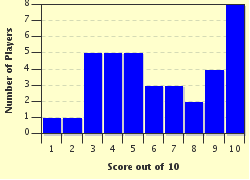Quiz Answer Key and Fun Facts
1. The full name of the person usually called Omar Khayyam in English-speaking countries was Ghiyath ad-Din Abu'l-Fat'h 'Umar ibn Ibrahim al-Khayyam Nishapuri. The last part of his name tells you that he was born in the town of Nishapur. In what country was this city, which no longer exists, located?
2. The 'al-Khayyam' in his name tells us that his father had what occupation?
3. Most Westerners are familiar with Omar Khayyam, if at all, because of his verses, known as the 'Rubaiyat of Omar Khayyam'. What does the word rubaiyat tell us about these poems?
4. What 19th century English poet is best known as the translator into English of the 'Rubaiyat of Omar Khayyam'?
5. While his poetry is what most associate with the name Omar Khayyam, he was best known during his life for his work as a mathematician. What was one of the most significant contributions to algebra that he made in his 1070 'Treatise on Demonstration of Problems of Algebra'?
6. In 1077, Omar Khayyam produced 'Sharh ma ashkala min musadarat kitab Uqlidis'. What name was given to the English version of this geometry-based work?
7. In exploring the Parallel Postulate (which describes what it means to say that two lines in the same plane are parallel to each other), Khayyam discussed a geometric shape that was later named after the Italian mathematician Giovanni Gerolamo Saccheri, who used it in 1733, over 600 years after Khayyam had first done so. What is the name of this figure?
8. Like most Persian mathematicians of his time, Omar Khayyam was also an astronomer. Because of his reputation, he was invited in 1073 to build an observatory in Isfahan, and use his team's observations to assist with what project?
9. In 1092, after the death of Sultan Malik-Shah I, Khayyam found himself persona non grata at the court. What action did he take as a consequence of this change in status?
10. Which Persian philosopher did Khayyam admire greatly, teaching his ideas to students during the final decades of his life?
Source: Author
looney_tunes
This quiz was reviewed by FunTrivia editor
bloomsby before going online.
Any errors found in FunTrivia content are routinely corrected through our feedback system.

